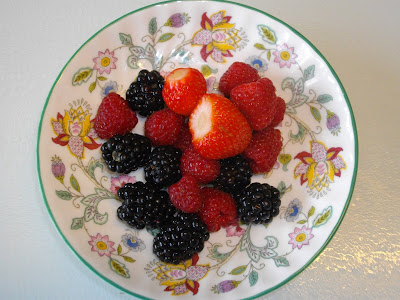Blackberries have made their welcomed appearance in our daily berry harvest. They are the first fruits I harvested out in the wild when I was a kid, and they bring back my wonderful childhood summers in a way that nothing else can.
 |
| Raspberries, blackberries, and strawberries |
I usually reserve my working in the front garden in the evening so as to avoid the enthusiastic representatives of various companies who want to improve our less than pristine dwelling--concerned insect killers, mowers of imaginary lawns (that's a prairie, Monsieur), insulators against Arctic weather, earnest eaves painters, facade cosmeticians, cladding pushers, and distinguished proponents of fire extinguishers. Though Dayo likes to hang out with me wherever I go, he seems to stay particularly close to me at twilight.
 |
| Dayo is thinking: Our house is pretty enough, no? |
Recently we were invited over for an apéritif held to celebrate the high school graduation of a young woman whom I had tutored in English for several months. On the morning of the apéro, she gifted me with a large potted bougainvillea to my great delight as I always wanted one. It will need to be carefully overwintered however because of our short but cold winters.
I did not bring my camera because we understood an apéro as meaning a few snacks and some drinks lasting the most an hour. Well, this turned out to be an apéro dinatoire, that is, essentially a banquet lasting hours though no cutlery was needed as all the food was in mouth-sized bites. Toothpicks sufficed. The superb food was so plentiful I can't see why I ever need to eat again. Platters just kept being placed on the table for nearly forty people: foie gras on herb-speckled brioche, warm creamy quiches and tantalising frittatas, carmelised plantains, salmon mousse gracing small circles of the softest imaginable bread, and sizzling pizza squares smothered with Gruyère cheese. We won't mention the wine, the punch, the chouquettes, and assorted delights like olives, peanuts, spicy tortilla chips, cherry tomatoes, and the biggest and fattest seedless green grapes I have ever seen. Madame M told me the younger guests were singing and having great fun till the early morning.
Another guest's garden flanks my host's garden and we were all gaping at his tomatoes, some of which were red, not many, but still red tomatoes in a neighbourhood filled with green ones were quite an attention getter. He said that it is an old wise French saying, that in order for tomatoes to blush, one needs to drop their pants. So, does that mean...? Next morning, both Madame M and I rushed over to our tomato beds expecting a miracle--perhaps some nice person did the necessaries? Alas green tomatoes greeted us, but with encouraging signs of yellowing. Often it is yellowing, as in peaches, and not necessarily reddening, that gives the earliest indication of ripening.
Preparation started six weeks ago by my sowing broccoli and Brussels sprouts in flats. About a month ago, the seedlings were transplanted into separate pots and are now ready to go into their prepared beds. These beds were recently harvested of their onions and garlic. I don't call my garden souped-up for no reason!
 |
| Brussels Sprouts seedlings |
 |
| Broccoli transplants in their bed, awaiting mulching |
Thankfully I had broccoli seedlings to spare because some caterpillars went by unnoticed and chomped away on a few. If you look carefully you will see a green caterpillar on the plant in the photo below. It has since been well squished along with other members of its family via my gloved hand. I never use pesticides on my crops, relying instead on hand removal and mechanical barriers.
Leeks which were seeded mid May are close to being pencil size and ready to be transplanted into their regular bed.
Because our frost date is usually around mid December, I will hold off sowing the crops with shorter maturation times like carrots, mache, beets, turnips, lettuce, spinach, escarole, and peas till mid August or until beds become free as summer harvesting is completed. If your frost date is earlier, then sowing can begin sooner. If the weather is hot, water the soil well and cool it down by covering it with burlap, shading cloth, or boards before sowing.
Though I tend to focus on annual flowers sparingly, preferring the more environmentally friendly choice of perennials, I choose those that will give a long blooming period. Pansies sowed in their flats six weeks ago are ready to be transplanted into bigger pots for eventual setting out for autumn through next spring blooming.
The zinnias sowed around end of May are ready to be transplanted for summer-through-autumn bloom.
If you keep your eyes out for cool-weather vegetable seeds/transplants, you too can harvest good food throughout autumn and/or get an early start for next spring, for example, by sowing and overwintering cold-resistant lettuce. The shorter days will make it impossible for lettuce to mature outdoors during the winter, but they will have formed good roots and sturdy little plants ready to burst into growth when the days become longer in early spring. Working the soil in late summer/autumn is usually easier than doing it early spring, a time that can be too hectic in the garden. Choosing the right varieties and sheltering overwintered plants under the appropriate layers of horticultural fleece will keep them in most cases cosy.





